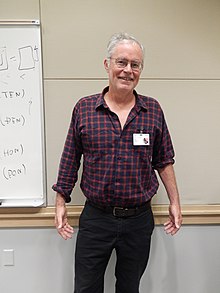Lee Collins (Unicode)
Appearance
Lee Collins | |
|---|---|
 Lee Collins at a meeting of ISO/IEC JTC 1/SC 2 at Redmond, Washington in June 2019 | |
| Occupation | Software engineer |
| Known for | Developing the Unicode Standard |
Lee Collins is a software engineer and co-founder of the Unicode Consortium. In 1987, along with Joe Becker and Mark Davis they began to develop what is today known as Unicode.[1] Collins has a Master of Arts in East Asian Languages and Cultures from Columbia University[2][3] and was the Technical Vice President of Unicode Consortium from 1991 to 1993.[4]
References
[edit]- ^ "Early Years of Unicode". www.unicode.org. Retrieved 12 December 2020.
- ^ "IMUG Events 2014 :: Unicode, TAUS, L20n, T9n Crowdsourcing, Google XL8, L10n Process, G11n Strategy, and more". www.imug.org. Retrieved 12 December 2020.
- ^ "Emoji lords to release 67 new symbols". ABC Australia. 24 November 2015.
- ^ "Previous Officers and Staff". www.unicode.org. Retrieved 12 December 2020.
Further reading
[edit]- Becker, Joseph D. (1998-09-10) [1988-08-29]. "Unicode 88" (PDF). unicode.org (10th anniversary reprint ed.). Unicode Consortium. Archived from the original (PDF) on 2016-11-25. Retrieved 2016-10-25.
In 1978, the initial proposal for a set of "Universal Signs" was made by Bob Belleville at Xerox PARC. Many persons contributed ideas to the development of a new encoding design. Beginning in 1980, these efforts evolved into the Xerox Character Code Standard (XCCS) by the present author, a multilingual encoding which has been maintained by Xerox as an internal corporate standard since 1982, through the efforts of Ed Smura, Ron Pellar, and others.
Unicode arose as the result of eight years of working experience with XCCS. Its fundamental differences from XCCS were proposed by Peter Fenwick and Dave Opstad (pure 16-bit codes), and by Lee Collins (ideographic character unification). Unicode retains the many features of XCCS whose utility have been proved over the years in an international line of communication multilingual system products.
Wikimedia Commons has media related to Lee Collins (Unicode).
